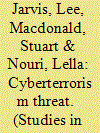|
|
|
Sort Order |
|
|
|
Items / Page
|
|
|
|
|
|
|
| Srl | Item |
| 1 |
ID:
132231


|
|
|
|
|
| Publication |
2014.
|
| Summary/Abstract |
This article reports on a recent research project exploring academic perspectives on the threat posed by cyberterrorism. The project employed a survey method, which returned 118 responses from researchers working across 24 different countries. The article begins with a brief review of existing literature on this topic, distinguishing between those concerned by an imminent threat of cyberterrorism, and other, more skeptical, views. Following a discussion on method, the article's analysis section then details findings from three research questions: (1) Does cyberterrorism constitute a significant threat? If so, against whom or what?; (2) Has a cyberterrorism attack ever taken place?; and (3) What are the most effective countermeasures against cyberterrorism? Are there significant differences to more traditional forms of anti- or counterterrorism? The article concludes by reflecting on areas of continuity and discontinuity between academic debate on cyberterrorism and on terrorism more broadly.
|
|
|
|
|
|
|
|
|
|
|
|
|
|
|
|
| 2 |
ID:
188761


|
|
|
|
|
| Summary/Abstract |
This article reports on a survey of researchers designed to capture current perspectives on core questions around cyberterrorism. The survey—conducted in 2017 as a follow-on to an initial, 2012, exercise—focused on questions of definition, threat and response. By documenting our findings in each of these areas—and highlighting developments in the years between our surveys—we identify three particularly important trends. First, an increasing convergence around the core characteristics of cyberterrorism, albeit with continuing conceptual disagreements at the concept’s penumbra. Second, increasing researcher concern with the threat posed by cyberterrorism, underpinned by a widespread view that this threat has increased, and a growing feeling that cyberterrorist attacks have now taken place. Third, support for a diversity of counter-measures to this threat, although perhaps counter-intuitively little suggestion that resort to exceptional or draconian measures is needed. In order to inform future research, the article concludes by detailing some of the major limitations, gaps and weaknesses within academic research to date as identified by our respondents.
|
|
|
|
|
|
|
|
|
|
|
|
|
|
|
|
| 3 |
ID:
041437


|
|
|
|
|
| Publication |
Hampshire, macmillan Press, 1990.
|
| Description |
xi, 206p.
|
| Standard Number |
0333493745
|
|
|
|
|
|
|
|
|
|
|
|
Copies: C:1/I:0,R:0,Q:0
Circulation
| Accession# | Call# | Current Location | Status | Policy | Location |
| 032617 | 382.64/MAC 032617 | Main | On Shelf | General | |
|
|
|
|
| 4 |
ID:
151571


|
|
|
|
|
| Summary/Abstract |
This article explores original empirical findings from a research project investigating representations of cyberterrorism in the international news media. Drawing on a sample of 535 items published by 31 outlets between 2008 and 2013, it focuses on four questions. First, how individuated a presence is cyberterrorism given within news media coverage? Second, how significant a threat is cyberterrorism deemed to pose? Third, how is the identity of ‘cyberterrorists’ portrayed? And, fourth, who or what is identified as the referent – that which is threatened – within this coverage? The article argues that constructions of specificity, status, and scale play an important, yet hitherto under-explored, role within articulations of concern about the threat posed by cyberterrorism. Moreover, unpacking news coverage of cyberterrorism in this way leads to a more variegated picture than that of the vague and hyperbolic media discourse often identified by critics. The article concludes by pointing to several promising future research agendas to build on this work.
|
|
|
|
|
|
|
|
|
|
|
|
|
|
|
|
| 5 |
ID:
178670


|
|
|
|
|
| Summary/Abstract |
Images are known to have important effects on human perception and persuasion. Jihadist groups are also known to make strategic use of emotive imagery and symbolism for persuasive ends. Yet until recently studies of the online magazines published by violent jihadist groups largely focused on their textual, not their image, content and, while the image content of these magazines is now the subject of a burgeoning number of studies, few of these compare the images used by different groups. This article accordingly offers a cross-group comparison, examining the image content of a total of thirty-nine issues of five online magazines published by four different jihadist groups. Starting with a content analysis, it shows that the images’ most common focus is non-leader jihadis. Using a news values analysis, it then shows how these images of non-leader jihadis are used to visually construct the identity of a “good Muslim.” This construct is characterized by three traits, each corresponding to a different news value: fulfilled (personalization); active (consonance); and respected (prominence). Moreover, these traits are intertwined: fulfillment comes from responding actively to the call to violent jihad, which in turn promises respect. The article concludes by highlighting some subtle differences between how the news values of personalization, consonance, and prominence are realized in the different magazines, and by discussing the implications of the “good Muslim” construct for efforts to develop countermessages.
|
|
|
|
|
|
|
|
|
|
|
|
|
|
|
|
|
|
|
|
|